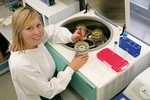Michelle a model for medical research
 Science Science
Michelle Zucker doesn't fit the science stereotype, not by a long shot. She's young, blonde, vivacious, and wouldn't look out of place on a fashion shoot. But the 25-year-old joint University of Adelaide and CSIRO Preventative Health Flagship PhD student is passionate about science and wants to spread the word to the broader community. It's no idle talk, either. In the past two years, Michelle has hit the promotional trail for the science world. This year she has taken on the role of public relations team leader for the Australian Society for Medical Research, as well as chairing the Australian Biotechnology Students Association. Both jobs require a dedicated commitment to raising the profile of science. She has also been involved in a number of initiatives, including presenting and meeting with science teachers and visiting primary schools, in an attempt to improve the way science is taught in schools. Michelle's research could provide vital clues to treating or preventing colorectal cancer, commonly known as bowel cancer. Bowel cancer is the most commonly diagnosed cancer in Australia, which kills on average 4500 people each year. There is currently no cure for bowel cancer, treatment options are limited and the main diagnostic tool can only detect bowel cancer that is already highly developed. Michelle's PhD, due to be completed in December, focuses specifically on a molecule called butyrate. Butyrate is a by-product of fibre breakdown and has been shown extensively to kill cancer cells, without damaging normal cells. "This is a very intense project which could have a huge impact in the long term," Michelle said. "There are only eight published papers in the world looking at the same thing I am, and together they are providing insights into how butyrate may be acting. My project hopes to take what we know a step further and identify the molecular mechanism of butyrate action." Up to 60% of bowel cancers are preventable by diet, so any breakthrough in understanding how fibre works will have significant implications around the world. "If we can determine how butyrate is able to distinguish cancer cells from normal cells, we can revolutionise bowel cancer treatment and avoid the debilitating effects associated with cancer and chemotherapy," she said. Michelle was recently awarded a High Commendation at the 2006 Unsung Hero of SA Science Awards for her science communication efforts, which was presented as a part of National Science Week. In August she also co-organised and facilitated the "Women on Top" Science Outside the Square event with Baroness Professor Susan Greenfield and Professor Caroline McMillen. The event attracted more than 800 members of the public including many school girls and parents of Walford Anglican School, who came to hear the women share stories about their lives as women in science. Michelle gained First Class Honours in Neurophysiology in the University of Adelaide's School of Molecular and Biomedical Science in 2002. Since 2003 she has been working on her PhD under the supervision of Professor John Wallace (University of Adelaide), Professor Richard Head and Dr Leah Cosgrove (CSIRO). Story by Candy Gibson
|





